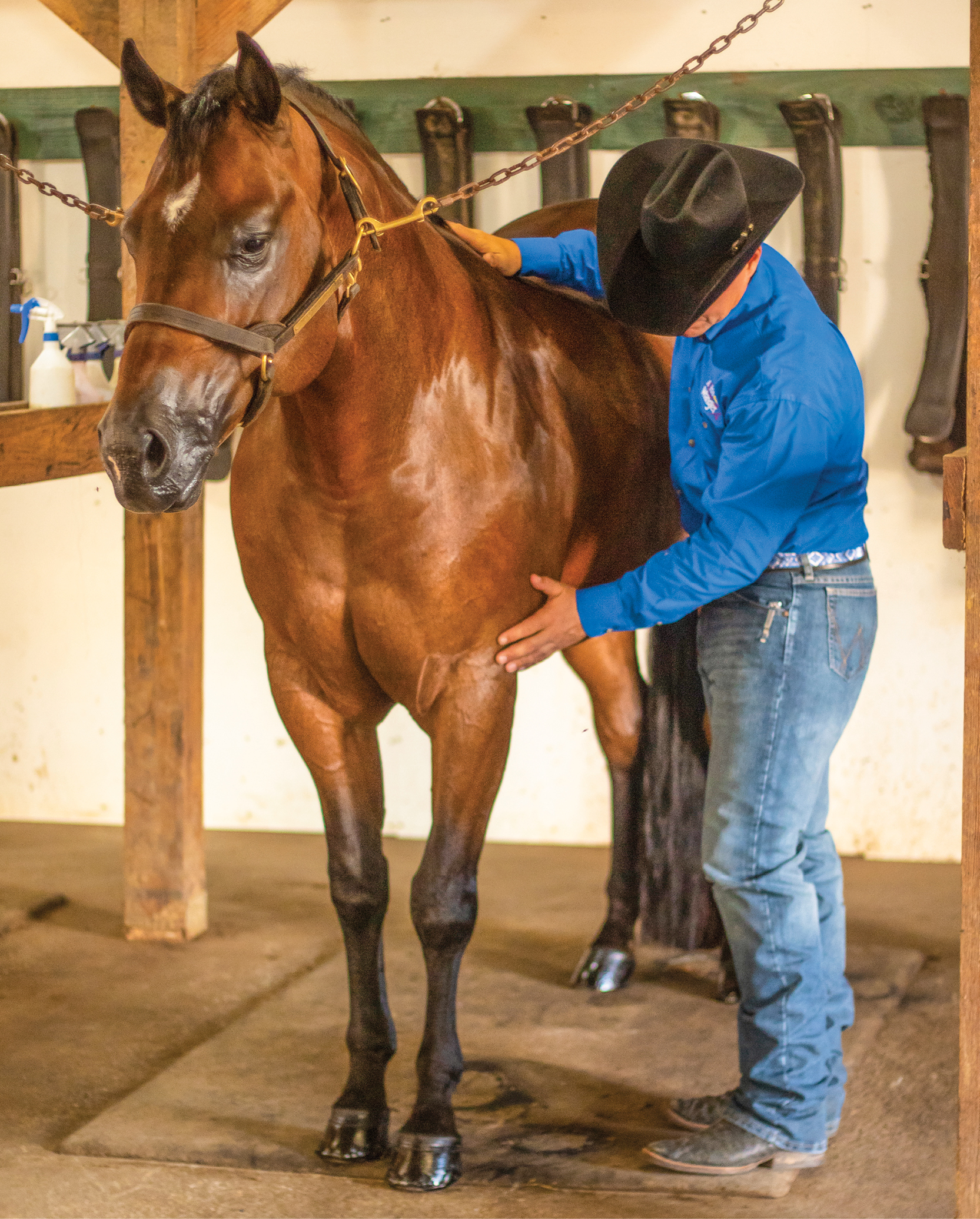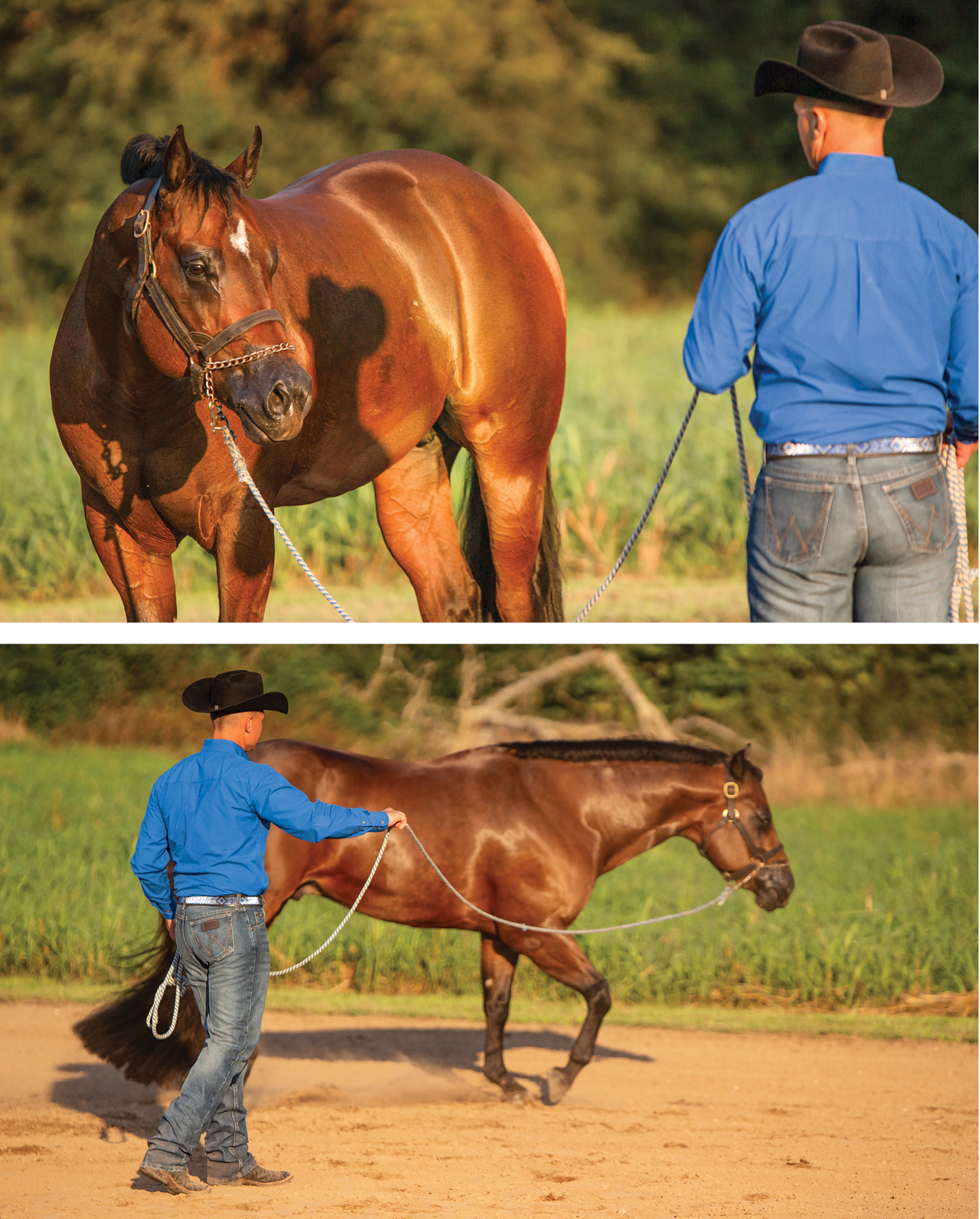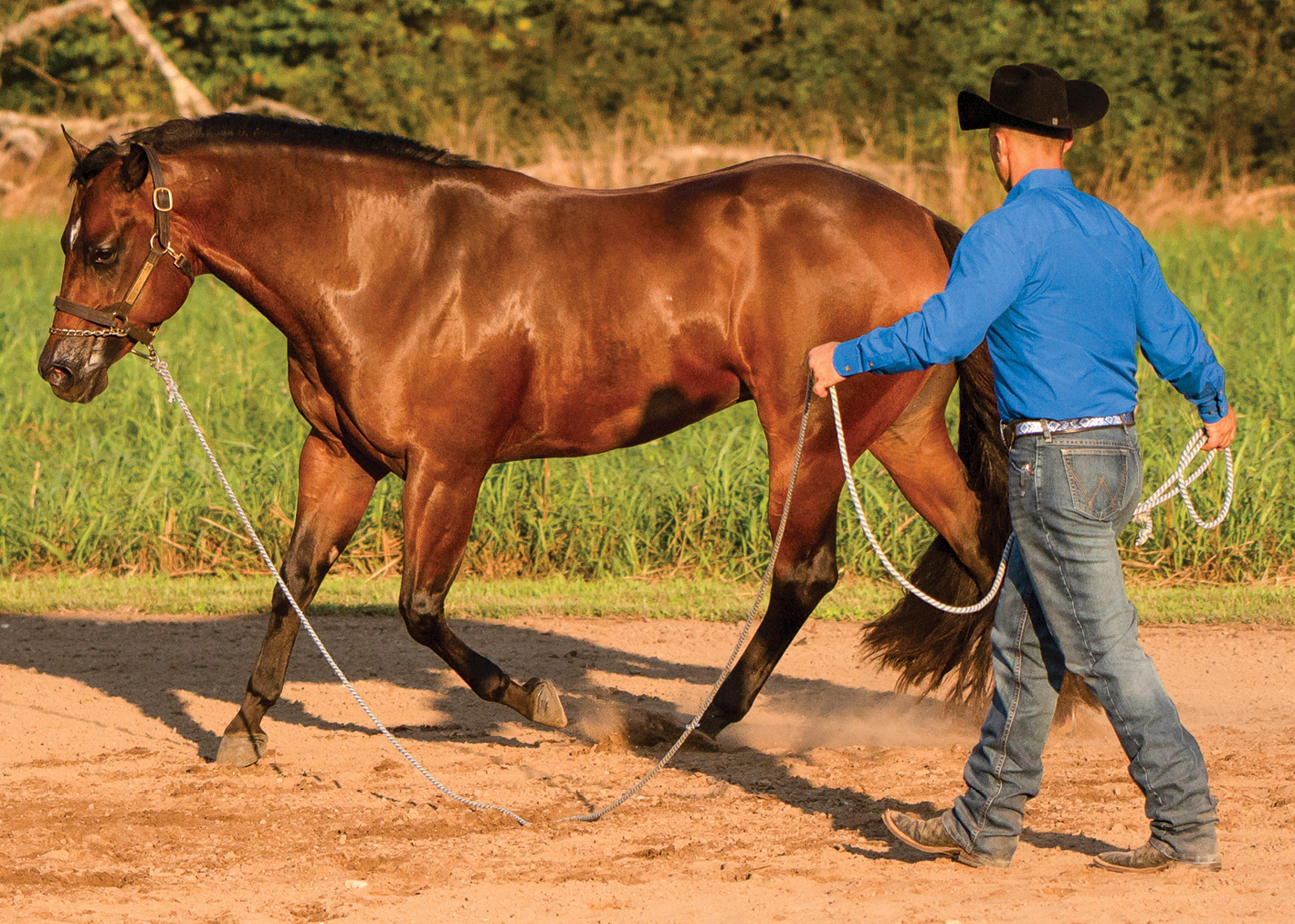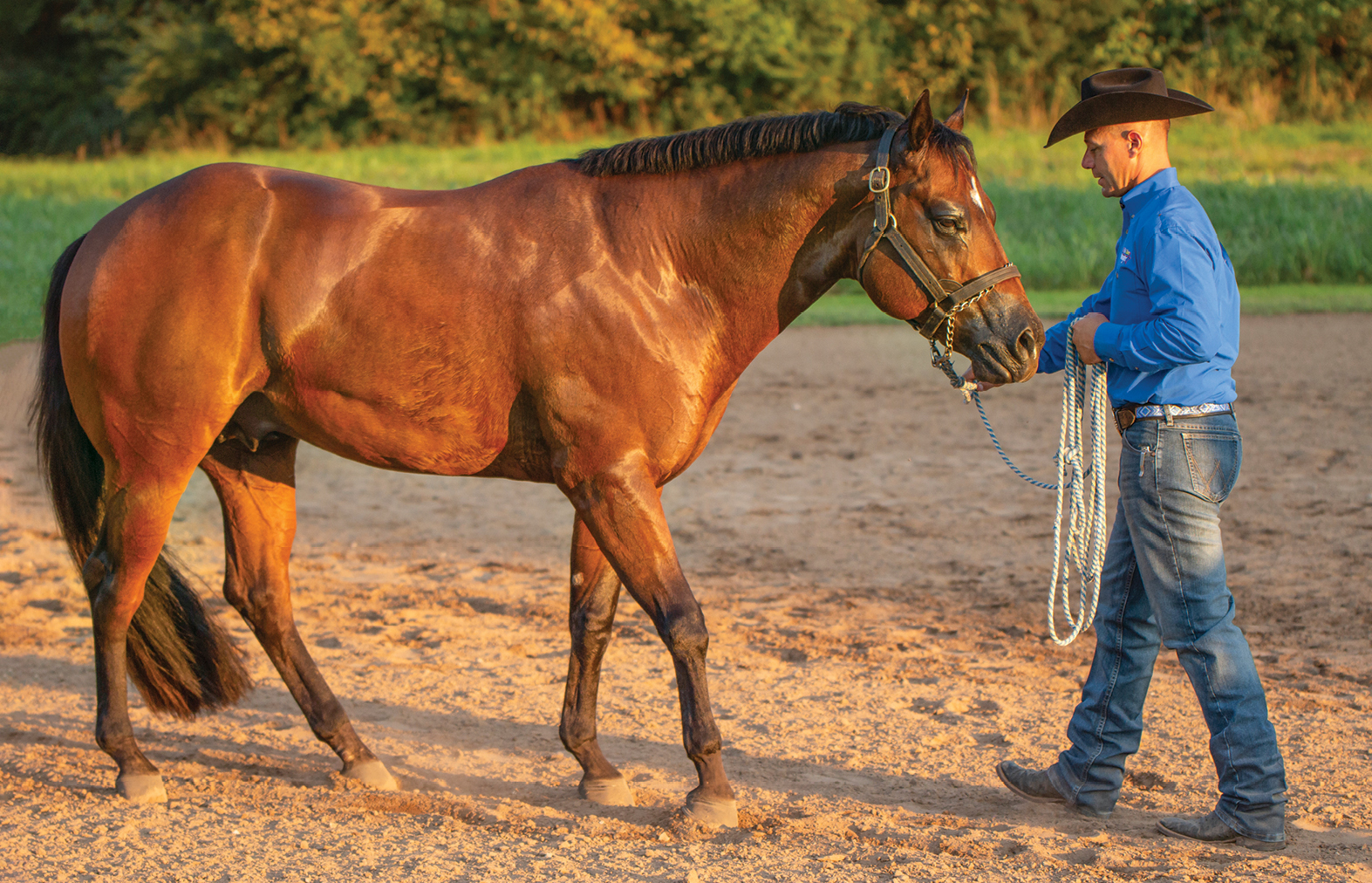When you work with a horse on the ground, it’s easy to underestimate the amount of communication that takes place between you and your horse. Even if you have only a half hour to work with your horse on a given day, the feedback from your horse during that time can be just as valuable as the feedback from an hour-long riding session. It’s not about the amount of time you have, but the kind of time you spend being productive with him.
[READ ABOUT: Build a Connection With Your Horse]
Here I’ll offer my best tips for using even a short ground-work session to get the most from your horse and build your relationship. I’ll help you break up your session into 5- to 10-minute increments so you can use your time wisely, set goals, and communicate your expectations to your horse so you can develop his mental and physical fitness for your next big show or trail ride.
THE FIRST FIVE MINUTES: GROOM FOR SUCCESS
 Never skip grooming your horse before any session—longeing or riding. Going over your horse with your hands and a brush helps you identify any physical problems that might need your attention. Plus it builds your relationship with your horse.
Never skip grooming your horse before any session—longeing or riding. Going over your horse with your hands and a brush helps you identify any physical problems that might need your attention. Plus it builds your relationship with your horse.Those first few minutes spent grooming are just as important as the rest of your training session. If you don’t spend quality time with your horse, you won’t get to know him, and that’s going to affect your working relationship.
When you brush your horse, you want to learn what’s going on with him. Ask yourself: Does my horse feel good? Is he stocked up? Does he have any blemishes? Go over him with your hands, gathering feedback as you go. It seems elementary, but if you rush this step or skip grooming, you’re not paying attention to what your horse is trying to tell you.
Start with a rubber curry to bring the natural oils of the skin to his hair coat. As you curry, take note of anything abnormal that might affect your horse’s performance or condition. Next, pick your horse’s hooves. Is he willing to pick his feet up? Is he behaving differently from yesterday? Has he lost a shoe? Note anything you see.
Your horse can’t verbally communicate with you, but he’s always communicating. The better you become at reading your horse, the better you’ll be able to understand him.
[READ ABOUT: Overcoming Horse Grooming Grumpies]
THE NEXT 10 MINUTES: LONGE LEFT, LONGE RIGHT
 Give your horse a chance to play, whether you’re free longeing or using a longe line. It allows him to express himself, play, and whinny. Use it as an opportunity to notice any alterations to his gaits or carriage.
Give your horse a chance to play, whether you’re free longeing or using a longe line. It allows him to express himself, play, and whinny. Use it as an opportunity to notice any alterations to his gaits or carriage.Longeing is as much mental exercise as it is physical. By longeing, you build your horse’s physical endurance, overall condition, and muscle mass. Additionally, when you ask your horse to focus on you and respond to your cues, you’re working on his mental fitness.
Whether free-longeing in a round pen or longeing on a line, give your horse a chance to play first. It’s important for your horse to run, whinny, and play, plus it allows you to evaluate his condition. Is he sound? How is he acting today? Was he the same way yesterday? Does he feel good? Is he lethargic? The answers give important feedback from your horse.
Once your horse has had a chance to play, it’s time to get down to business. First, zero-in on whether he’s paying attention to you and responding to your cues.
[READ ABOUT: Establish Control on the Longe Line]
 TOP: Consistency is key for any cue, especially when you ask your horse to stop. Using the same cue each time teaches your horse to respond in a very specific way, setting him up for success in every training session that follows. BOTTOM: Pay attention to where your body is in relation to your horse’s body. If you’re in front of his shoulder and ask him to go forward, you’ll confuse him. Use your energy from behind the girth area to urge him forward.
TOP: Consistency is key for any cue, especially when you ask your horse to stop. Using the same cue each time teaches your horse to respond in a very specific way, setting him up for success in every training session that follows. BOTTOM: Pay attention to where your body is in relation to your horse’s body. If you’re in front of his shoulder and ask him to go forward, you’ll confuse him. Use your energy from behind the girth area to urge him forward.Check the Look: If your horse is looking away from you, you’re not his focal point. Maybe he sees his buddy in the pasture or there’s another stimulus. To check focus, ask him to stop two or three times. Use a direct tone and say, “whoa.” Your horse should respond to you. On the longe line or in the round pen, I define “whoa” as all four feet on the ground, standing still, slightly turned toward me, with one eye and one ear on me.
If your horse doesn’t respond, he may not know that he needs to turn toward you and focus on you, so you must show him what you want. Take hold of the longe line softly to turn his nose toward you. It may take a few times before your horse learns what whoa on the longe line means, but you must be consistent.
Consistency is king. You’re teaching behavior modification. If you apply a consistent cue or signal to your horse, you’re asking him to respond in a very specific way. So be consistent. Don’t say “whoa” today and “stop” tomorrow. Every day should be the same expectations with the same cue. With consistency and time, if you can master verbal commands on the ground, especially “whoa,” that’ll help you establish those same commands in the saddle.
Use Your Body: Along with consistent cues and a clear, direct tone, use body language. You need to know where your body is in relation to your horse’s body because it affects your cues. Strive to actively communicate with your horse. Whether he’s on the line or free-longeing, you’re the center of the circle and your horse is working around you. Walk a small circle so you stay level with your horse’s girth area and hip.
Use your energy to push your horse forward from behind the girth. When you stop pushing or take a half-step back along with saying “whoa,” you give your horse a visual cue and a verbal cue to stop. You’re taking the pressure off your horse and applying the brakes. If your horse struggles with forward motion, move and push forward more strongly from the hip. If you have a super-sensitive horse, he may respond more strongly to slight turns of your body.
Work on Gaits and Transitions: Just like with the stop, keep your cues consistent. If you want to say “walk,” “trot,” or “lope” or if you want to cluck, just be sure you keep your cues and expectations consistent from day to day. Once your horse focuses on you, ask for different gaits and upward and downward transitions. Work your horse in both directions on the line or in the pen to build muscle memory, stamina, and muscle mass. Strive for balance at all gaits. There are always areas for improvement at each gait.
 Use your voice for gait commands, whether the word for the gait (e.g., saying “trot!”) or clucking, consistently. Work your horse through all gaits, working on upward and downward transitions.
Use your voice for gait commands, whether the word for the gait (e.g., saying “trot!”) or clucking, consistently. Work your horse through all gaits, working on upward and downward transitions.Troubleshoot the Lope: Your horse should be on the correct lead. Two common problems can happen instead.
First, your horse might pick up the outside lead and begin to counter canter. Bring your horse back to the trot, establish a good, balanced, two-beat trot, and ask your horse to lope off again on the correct lead. Repeat the process until he strikes off on the correct lead.
Or your horse might cross canter or crossfire—lope off on the left lead in front and the right lead behind. It’s an unnatural gait for your horse, and you don’t want him to develop the habit or muscle memory for this gait. Remedy the cross canter the same way as the counter canter. Bring your horse down to a balanced trot (which allows you to work on that downward transition) and ask for the lope again.
The cross-canter can also serve as feedback. If your horse never cross canters and one day he does, take notice. It could indicate soreness, lameness, or some underlying physical ailment you should pay attention to. The same is true of picking up the wrong lead. If your horse always picks up the correct lead and one day he doesn’t, look into that. Read your horse every day, even in small increments of time.
Level Up: If you’re used to longeing on the line, change things up by free-longeing your horse in a round pen. It may be more difficult to stop your horse or capture his focus during free-longeing, whereas forward motion can be an issue with longeing on the line. Both of those items provide you with a focal point for longeing exercises.
10 MORE MINUTES: LEAD AND FOLLOW
This exercise establishes simple ground control and your horse’s awareness of you. If your horse walks all over you on the ground, he’ll walk all over you when you’re in the saddle. You must establish boundaries to keep yourself safe.
Simple Concept: To help build boundaries, think of it this way: Your horse’s bubble is never allowed to come into your bubble. You can develop these bubbles with the simple principle of “move to pressure, come to pressure.” In this exercise, you’ll apply a basic signal and expect a simple response.
If you move your bubble toward your horse’s bubble, he should give way to you. Move toward him, say “back,” and shake your lead rope. You’re looking for a step or two away. That’s a success.
 If you move your bubble toward your horse’s bubble, as when asking him to back up, for example, he should yield to you and move away so your bubbles never cross.
If you move your bubble toward your horse’s bubble, as when asking him to back up, for example, he should yield to you and move away so your bubbles never cross.If you want your horse to come toward you, apply pressure by pulling him toward you and stepping back, effectively moving your bubble back and inviting him to bring his bubble forward.
Big Picture: This exercise is very basic, but these principles can be applied to a lot of different situations. If you’ve already taught your horse these simple lessons, use those lessons during a stressful or difficult situation. If your horse doesn’t like to load in the trailer, for example, the concept of “move to pressure, come to pressure” can be a lifesaver. If you’ve taught your horse to give to pressure in 30-minute sessions over a few weeks’ time, you don’t have to teach that concept during a scary situation like loading. You can give the cue and he will respond.
Level Up: If you and your horse have already mastered this concept, start working on steering to the left or right while backing your horse. Lay out poles or logs in an “L” shape on the ground and back your horse through it.
THE FINAL FIVE MINUTES: RELAX TOGETHER
No matter how rushed you are, take time to be with your horse. In this quick session, you’ve checked your horse’s health with grooming, increased his physical fitness with longeing, and exercised his brain with simple exercises and responses to cues. Now it’s time to relax. If your horse can’t stop and take a deep breath with you, he won’t trust you. Hose him down, hand-graze him, and get to know your horse. Enjoy being with him and remember that this is one of the best parts of horsemanship.
LESSONS LEARNED
Think of your non-riding training time as an investment. When you spend 30 productive minutes on a bright, sunshiny day—or a even a gloomy, wet day—with your horse, that’s money in your training bank. By working on those little ground lessons when you had the time you can cash it in on a day that it really matters—such as when your horse won’t load in the trailer at the show and you find yourself at the other end of the lead rope, wondering what to do. Recall those simple ground control drills, apply the signals, and your horse will respond. Small investments can yield big results.
SIDEBAR
For Trail Riders
Whether you’re a weekend trail rider or love longer adventures, it’s important to prepare your horse for the activities you’ve got planned.
• Focus on physical fitness. If you plan to ride for six to eight hours a day for five days, it’s only fair to prepare your horse for that kind of exercise. Longeing on the flat is great exercise, but it’s no substitute for riding over mountainous terrain.
• Don’t skip grooming. Just because you’re not competing doesn’t mean you can jump past the grooming process. Take the time to note cuts, scrapes, and blemishes and note any soreness.
• Know your horse’s baseline. When you get to your trail ride, is your horse acting normal? Maybe he got nervous or he has a belly ache. Knowing what he’s like every day, which is achieved with the lessons in this article, is helpful for troubleshooting behavior or health problems on the trail.
• Bring your longe line. If your horse arrives at the trail head or campsite and he’s nervous or energetic, grab your longe line and gain your horse’s focus with simple stops and gait changes. If you’ve established those cues and responses at home, you can use them when you need them.
For Competitors
Use longeing exercises at the show to refocus your horse and sharpen his responses to simple cues. Your emphasis should always be on the consistency of your expectations and your cues, whether you’re at home or at the show.
• Be ready. Prepare your horse physically for the show season. Longe, ride, and work on your gaits and transitions.
• Put in the elbow grease. Groom for a shiny hair coat and to build familiarity with your horse’s physical condition and baseline.
• Build a routine. Be consistent with your cues and expectations at home, and take those same cues and expectations to the show pen. If it was OK for your horse to take five steps after you say “whoa,” at home, but as soon as you get to the horse show you expect an immediate stop after “whoa,” that’s not going to happen. Be fair with your expectations at home and at the show.







